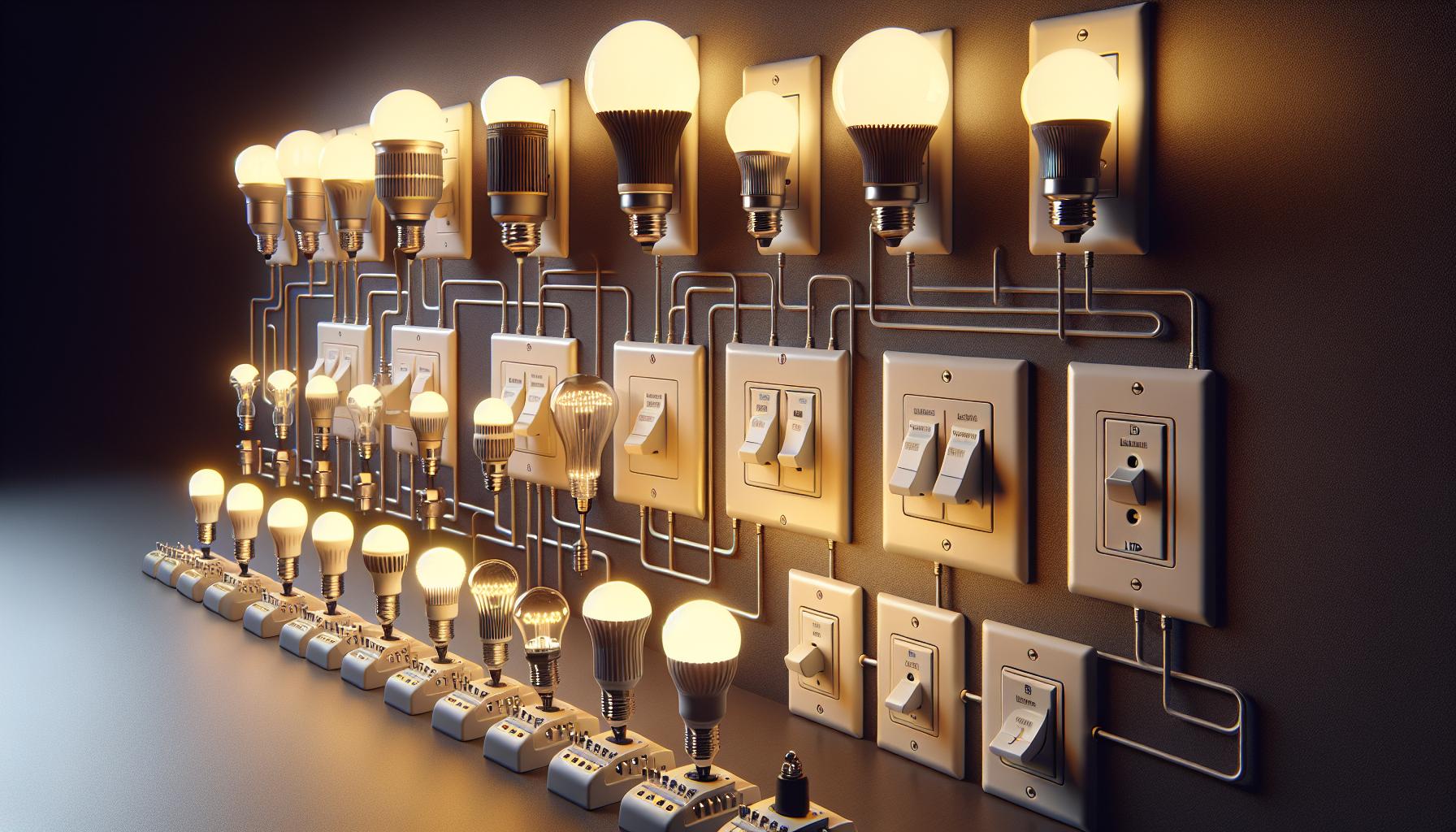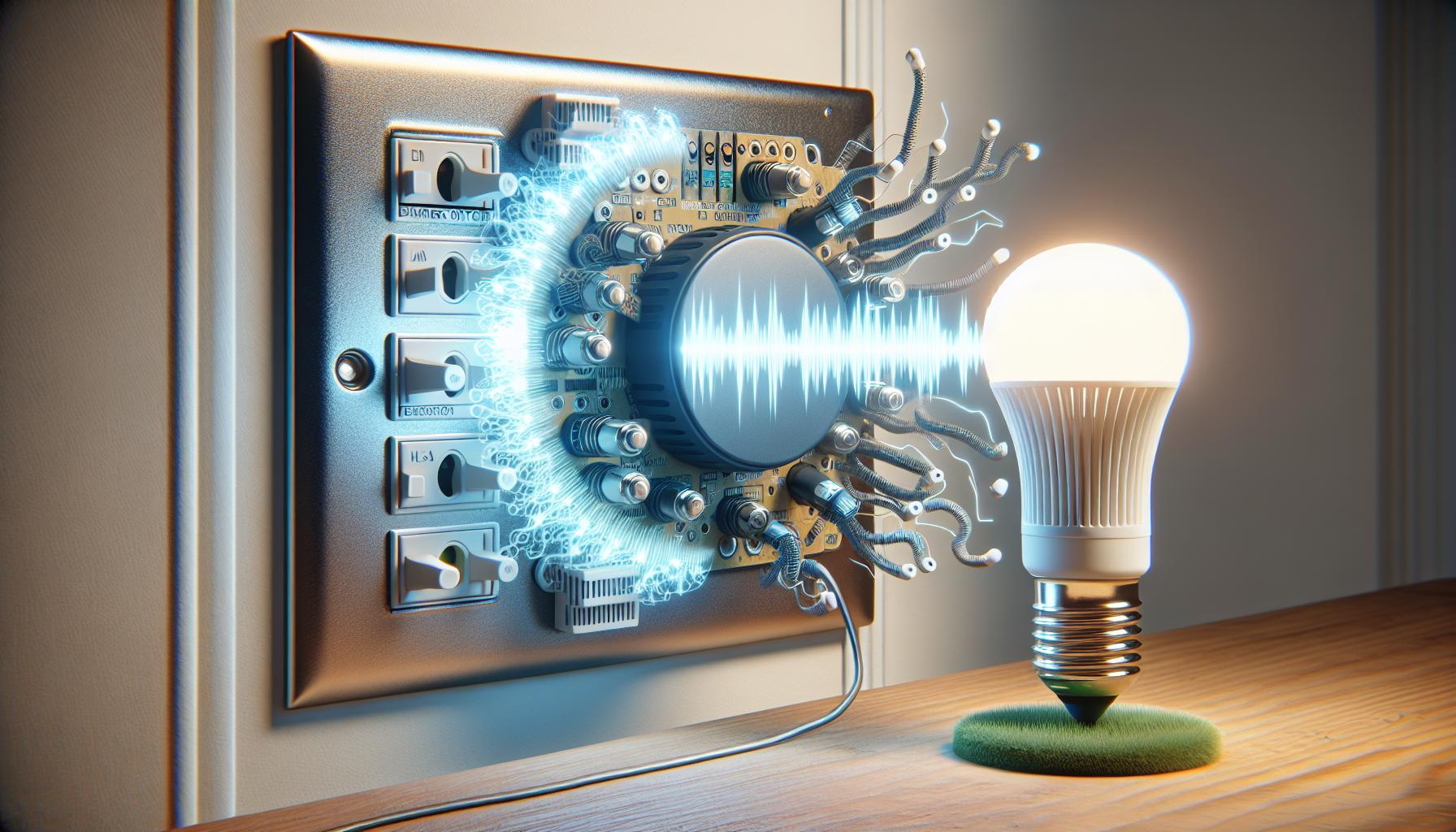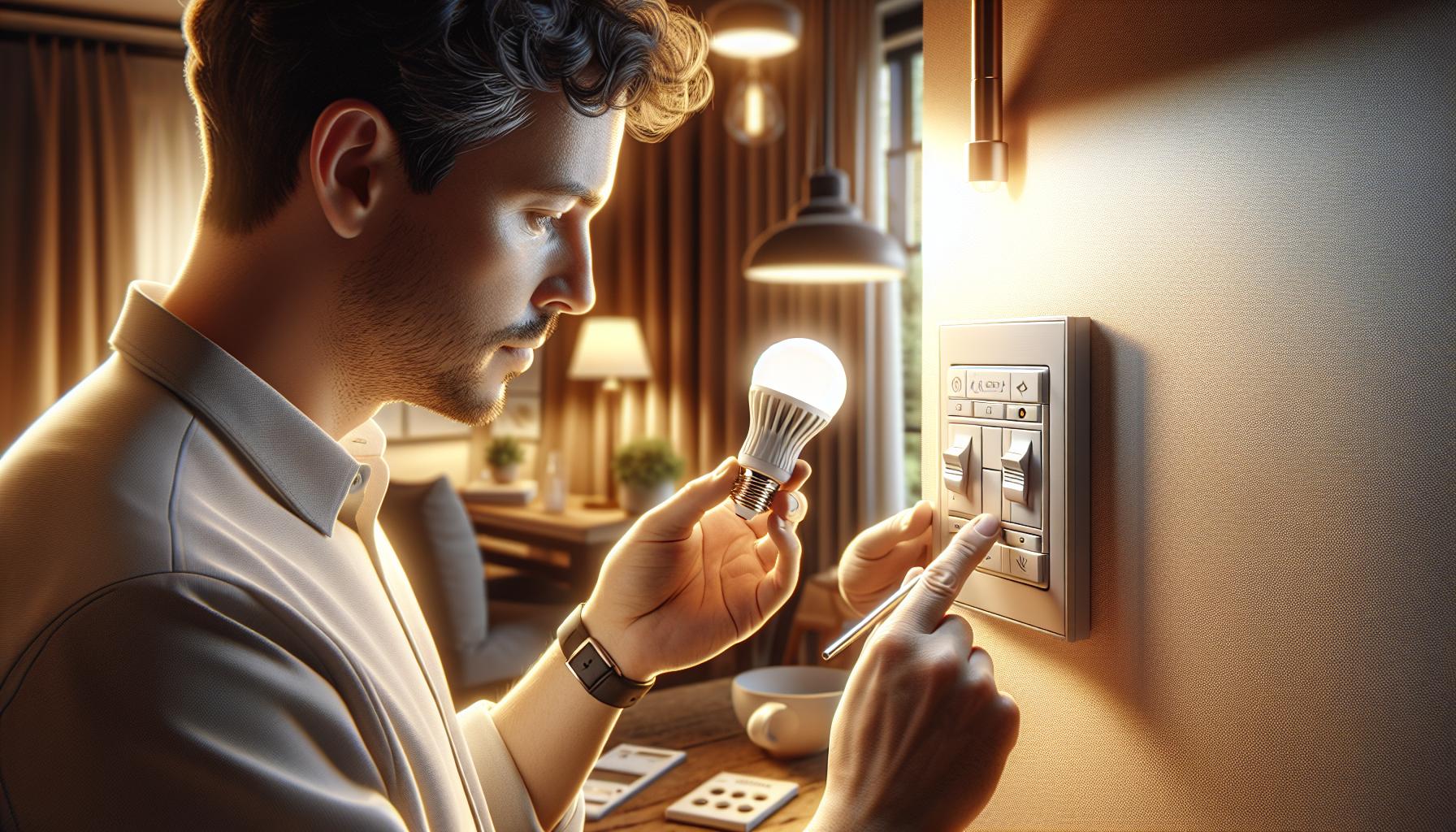Ever tried to set the mood with your LED lights, only to find they won’t dim? You’re not alone. It’s a common snag when you’re shifting from traditional bulbs to LEDs. But don’t worry, you’re about to get the lowdown on how to make LED bulbs and dimmer switches work together like a charm.

You might think any dimmer switch will do the trick, but there’s a bit more to it. Not all LED bulbs play nice with older dimmer models, and that’s where you might hit a snag. But with the right info, you’ll be dimming those lights and enjoying the ambiance in no time.
So, before you dive into the world of LED dimming, let’s make sure you’ve got the essentials down. With a few quick tips, you’ll be ready to create the perfect lighting for any mood or occasion.
What is a dimmer switch?
As you delve into the world of custom lighting, it’s crucial to understand the tools at your disposal. One such tool is the dimmer switch. Traditionally, a dimmer switch replaces your standard light switch and offers the ability to adjust light intensity with ease. Think of it as your personal lighting volume control, allowing you to fine-tune the atmosphere in any room to match your mood or the occasion.
Dimmer switches work by varying the voltage supplied to the light bulb, which in turn adjusts the brightness of the light. They come in various forms, including rotary knobs, sliding levers, or even touch-sensitive panels. With the advent of smart home technology, you’ll also find wireless dimmers that connect via Wi-Fi or Bluetooth, making it possible for you to adjust lighting levels from your smartphone or through voice commands.
Here’s an important thing to keep in mind: not all dimmer switches are built the same. Some are designed for incandescent bulbs while others are made to handle the lower power requirements of LEDs. That’s why pairing your LED with a compatible dimmer is essential. Otherwise, you might experience issues like flickering, buzzing, or inadequate dimming range, and who wants that?
But why dim your lights in the first place? Apart from creating a cozy or dramatic ambiance, dimming LEDs can contribute to energy savings and even extend the life of your bulbs. When you reduce the light output, you’re also reducing energy consumption, which can lead to lower electricity bills. Plus, when LEDs operate at less than maximum power, they don’t heat up as much, which can prolong their lifespan. It’s a win-win!
To ensure you’re equipping your home with the right dimmer switch for LED bulbs, look for products specifically labeled for LED compatibility. This simple step will help you avoid common pitfalls and set the stage for a seamlessly dimmable home lighting system.
Can LED bulbs be used with dimmer switches?

Absolutely, LED bulbs can be paired with dimmer switches, but there’s a bit more to it. Unlike incandescent bulbs, LEDs require a specific type of dimmer, typically referred to as an LED-compatible dimmer. These dimmers are specially designed to handle the lower wattage of LEDs and to manage the unique way that LEDs draw power.
When you’re delving into the world of LED dimming, look for bulbs labeled as “dimmable.” Not all LED bulbs are made to work with dimmers, and using a non-dimmable LED bulb with a dimmer switch can lead to all sorts of annoyance, like flickering, buzzing, or even premature bulb failure.
It’s a bit like pairing a fine wine with the right cheese. You need to match the performance characteristics of your LED bulb with a compatible dimmer switch. To do this effectively, refer to the bulb’s packaging or spec sheet. Manufacturers often provide a list of compatible dimmer switches that are guaranteed to work seamlessly with their bulbs.
Remember, even within the realm of dimmable LEDs, performance can vary. Some bulbs might dim down to just 10% of their full brightness, while others can go down to a nearly moonlit glow at 1%. This performance is also heavily dependent on the dimmer switch you pair with your bulb. Here’s a handy table to show you what to expect from different dimmable LEDs:
| LED Bulb Model | Dimmability Range | Compatible Dimmer Switch Model |
|---|---|---|
| BrightNest Dimmable A19 | 10% – 100% | Lutron Skylark S-600P |
| GlowRight Par20 | 1% – 100% | Leviton TSL06-1LT |
| EcoShine BR30 Flood | 5% – 100% | Philips Sunrise DVW600PH-3 |
Upgrading to LED-compatible dimmers might seem like a hassle, but it’s worth the effort. Not only do you get the energy efficiency of LED lights, but you also maintain the ability to adjust your room’s ambiance as you wish. The right dimmer switch and LED combination can transform a room from a bright, vibrant space to a soft, relaxing haven with just a touch.
Understanding compatibility issues

« Are Light Bulbs E-Waste? Discover Proper Disposal Methods
How to Keep Light Bulbs from Sticking: Unlock Easy Removal Tips »
When you’re diving into the world of lighting, especially the nuances of LED dimming, compatibility isn’t just a buzzword – it’s the cornerstone of your project’s success. LED dimmers are engineered to match the electrical needs specific to LED bulbs, which, if overlooked, can lead to several issues. Let’s shed some light on what could go wrong if you pair an incompatible dimmer with your LED bulbs.
First off, you might notice flickering or stroboscopic effects when you try to dim your lights. This isn’t just annoying; it can be a real mood killer when you’re striving for that perfect ambience in your home. This happens because traditional dimmers chop the current to control the light output, which works fine for incandescent bulbs but can wreak havoc on the sensitive electronics within LEDs.
Another sign of incompatibility is buzzing. While a little buzz might seem negligible, keep in mind that it’s indicative of a deeper struggle going on within your lighting circuit. LEDs buzzing are akin to a cry for help – it’s a signal that your current dimmer switch isn’t communicating effectively with the bulb.
You could also end up facing limited dimming range, where your LED bulb only dims to a certain point or, conversely, doesn’t allow you to crank up the brightness to its full potential. Lighting isn’t just about seeing your way around a room; it’s about crafting an environment that suits your mood and activity. And when you can’t dial in that exact lighting level, well, you’re essentially flying blind in your own home decor mission.
But here’s the kicker: premature failure of the LED bulb. No one wants to frequently replace bulbs, right? It’s both a hassle and not exactly pocket-friendly. An incorrect dimmer switch can reduce the lifespan of your LEDs, making that switch from traditional to LED lighting seem less appealing.
How to determine if your LED bulbs are dimmable

Determining if your LED bulbs are dimmable isn’t just wise; it’s crucial for creating that perfect ambiance without the hassle of trial and error. Luckily, you can follow some simple steps to make sure you’ve got the right bulbs for your dimming desires.
First and foremost, check the packaging. Manufacturers know you’re looking for this feature, so they tend to make it clear. Look for the word “dimmable” on the box. If it’s not there, the bulb likely isn’t built to dim without issues.
Don’t stop at the packaging—take a peek at the spec sheet or the bulb itself. Sometimes, manufacturers go the extra mile to provide compatibility details right where you can’t miss it. You’re looking for terms like “dimmable with leading-edge” or “trailing-edge dimmer switches.” This bit of info is your golden ticket to ensuring you’re armed with the correct bulbs.
Here’s what you can check:
- Packaging: Labels and symbols indicating dimmability.
- Bulb: Imprinted info that may reference dimming capabilities.
- Spec Sheet: Detailed compatibility with dimmer types.
Can’t find any clear indicators? Take it to the web. Look up the model number online. Manufacturers usually brag about the dimmability of their LEDs on their websites or in product catalogs.
You might be thinking, what if I’ve lost the packaging, and there’s no model number in sight? Well, you’ve got the power of observation on your side. Install the bulb and give it a go with a known LED-compatible dimmer. The proof is in the pudding—or in this case, the dimming. If your bulb dims smoothly without flickering or buzzing, you’re probably in the clear. But it’s important to keep in mind that this isn’t a fail-proof method for compatibility.
Remember also that even within dimmable LED bulbs, the performance can vary. Some bulbs can dim lower than others without turning off or flickering. It’s a bit like finding the right key for a lock—making sure the dimmer and the bulb are in perfect harmony unlocks the full potential of your lighting.
How to choose the right dimmer switch for LED bulbs

When you’re upgrading your home lighting to LED, selecting the right dimmer switch is a bit like finding the perfect pair of shoes; it’s all about compatibility and comfort. If you’ve ever tackled a DIY project, you know the frustration of mismatches. To save yourself that hassle, it’s crucial to ensure your LED bulbs and dimmer switches are a perfect pairing.
Understand Dimmer Switch Types
First up, know that dimmer switches come in two main types:
- Leading-edge dimmers, traditionally used with incandescent bulbs, which may cause issues with LEDs such as flickering and reduced lifespan.
- Trailing-edge dimmers, specifically designed for the lower load of LED bulbs, providing smoother control and an overall better dimming experience.
Always check the type of dimmer installed in your home before purchasing new LED bulbs.
Check Compatibility
LED bulbs have specific requirements, so it’s vital to:
- Look for a dimmer that specifies it is compatible with LEDs. This info is often found on the dimmer’s packaging or product description.
- Cross-reference the dimmer switch with your bulb’s make and model. Many manufacturers provide a list of compatible dimmer switches for each bulb.
Here’s a handy tip: Match the wattage of your LED bulbs to the dimmer’s range. For instance, if your dimmer can handle up to 150 watts of LEDs, and you’re installing ten 10-watt bulbs, you’re good to go.
Read the Reviews
Peek at what other DIYers have to say:
- Online reviews can be a treasure trove of info on a dimmer’s performance with certain LED bulbs.
- Pay special attention to feedback mentioning your specific bulb model.
Test Before You Commit
If possible, test out the dimmer switch with a sample bulb. This step can go a long way to ensure you won’t encounter dimming issues after installation. Remember, every home’s lighting environment is unique, just like your DIY projects. Trial and error may be part of the process, but it’s worth it for that seamless, cozy dimming effect you’re after.
Tips for dimming LED lights effectively
When you’re tackling home DIY projects, few things are as satisfying as perfecting the mood with the right lighting. Dimming LED lights may seem straightforward, but there’s an art to getting it just right. Here are some expert tips that you’ll find handy while dimming your LED lights effectively.
Ensure Compatibility
Firstly, you’ve got to make sure your LED bulbs and the dimmer switch are compatible. Unlock the full potential of your dimming capabilities by matching the dimmer type with the bulb. Remember the earlier mention of leading-edge and trailing-edge dimmers? Stick with trailing-edge for LEDs to avoid issues like flickering and reduced bulb life.
Check the Wattage
Next on your checklist should be the wattage. Every dimmer switch is rated for a certain wattage range. Ensure that the total wattage of your LED bulbs doesn’t exceed the dimmer’s capacity. This means if you’re lighting up a chandelier with multiple bulbs, add up the wattage of all the bulbs to see if they fall within the switch’s specified range.
- For trailing-edge dimmers: Use bulbs well within the lower wattage limit.
- For leading-edge dimmers: Avoid them with LEDs if possible.
Adjust the Dimmer Settings
Many LED-compatible dimmers come with adjustable settings that allow you to set the minimum and maximum light levels. This prevents the lights from turning off at lower settings or not dimming enough at higher settings.
Test Before Full Installation
Before you commit to installing multiple dimmers throughout your space, test with a single switch and bulb. This lets you tweak the settings and make adjustments without the hassle of redoing your entire setup.
Pay Attention to the Quality of Your Bulbs
Not all LEDs dim the same way. High-quality LED bulbs often have better dimming capabilities, minimal buzzing, and a wider dimming range. It’s worth investing in reputable brands, especially for areas in your home where ambiance is key.
By following these tips, you’ll enhance your home’s atmosphere and extend the life of your LEDs. Just imagine the perfect glow at dinner or the soft light for movie night—it’s all within reach when you dim your LED lights the right way. Now, get ready to bask in the perfect ambiance that you’ve crafted, all with the flick of a switch.
Conclusion
So now you’ve got the scoop on pairing LED light bulbs with dimmer switches. Remember, it’s all about compatibility and fine-tuning. Make sure you’re using the right type of dimmer and that your LED bulbs are up for the task. A little bit of testing and adjusting can go a long way in achieving that perfect ambiance in your space. Here’s to setting the mood just right and enjoying the glow of your well-dimmed LEDs for years to come!
Frequently Asked Questions
What type of dimmer is recommended for LED lights?
LED lights perform best with trailing-edge dimmers, which are designed to handle the lower electrical load of LEDs and minimize issues such as flickering and reduced bulb lifespan.
How do I ensure my LED lights and dimmer are compatible?
Check that your LED bulbs are ‘dimmable,’ and confirm that the dimmer switch is compatible with the type and wattage of the LED bulbs you intend to use.
Why is it important to check the wattage compatibility between LED bulbs and dimmers?
Using LED bulbs within the wattage capacity of the dimmer switch ensures proper functioning, avoids overloading the dimmer, and helps prevent performance issues with the LEDs.
What should I do if my LED lights turn off at lower settings or don’t dim enough at higher settings?
Adjust the dimmer settings or calibration to tailor the performance to your preferred lighting levels, ensuring LEDs do not turn off or remain too bright when dimmed.
Is it necessary to test with a single switch and bulb before installing multiple LEDs and dimmers?
Testing with a single switch and bulb is recommended to confirm compatibility and performance before fully outfitting your home, saving time and costs associated with extensive troubleshooting.
How does the quality of LED bulbs affect dimming capabilities?
Higher quality LED bulbs tend to have better dimming capabilities, leading to smoother dimming, fewer flickering issues, and a more reliable performance overall.




